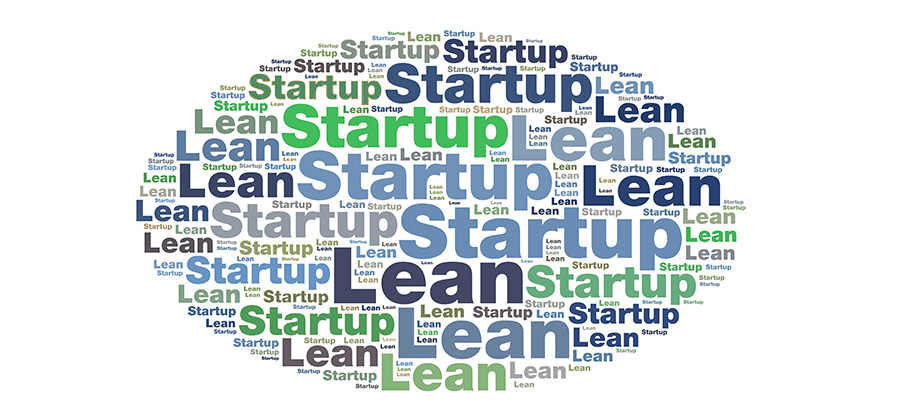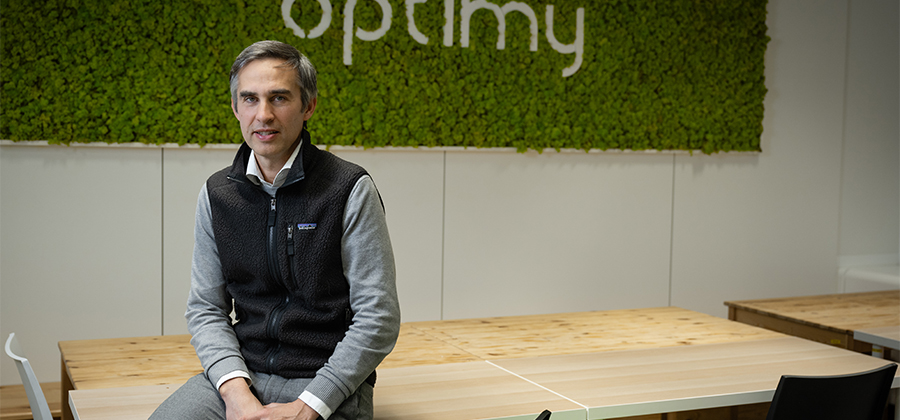Established companies engage in incremental innovation; start-ups engage in disruptive innovation. It is a fight between David and Goliath, and we all know how that turned out.

Imagine a lush meadow under the spring sunshine. Two professional musicians in smart suits are playing Sonata for flute and harpsichord by Johann Sebastian Bach. Suddenly those sweet sounds are ripped to shreds by an electric guitar. It is the well-known riff from Start Me Up, the hit song by The Rolling Stones. When the bass and drums also join in, the classical music perishes in an orgy of electrically amplified instruments. Keith Richards' furrowed face is lit by a wicked grin.
The fantastic music by J.S. Bach symbolises the established companies here. Their approach is well-considered; their products are polished. They have built a longstanding relationship of trust with their customers. Everyone thinks that they can continue like this for a very long time to come. Is The Rolling Stones' music as great as Bach's? That is certainly up for discussion. In any case their music is different. Rough, less polished, aiming for a direct impact. And certainly not less commercial. The rock songs by Jagger and Richards symbolise the young start-ups here. They disrupt the peace of the established companies and sometimes even bring the biggest players down.
Playing by different rules
The Rolling Stones were innovative. They revamped the old blues, consciously cultivated their bad boy image and made good use of the mass media to put themselves out there in the market. They were disruptive – rupturing and devastating – before their time. Of course, classical music also uses modern recording and distribution techniques, but that is more of an incremental innovation, a gradual change. The product itself does not evolve much anymore. The difference between these two notions – incremental and disruptive innovation – is essential for companies, according to Cedric Donck, business angel and founder of the Virtuology Academy.
"Established companies engage in incremental innovation. They improve their products or services step by step, but they stay in the same business model. In the hotel sector, this means we make sure our rooms have Wi-Fi, we are on TripAdvisor, we have an attractive website and so on.
Start-ups engage in disruptive innovation. They play by different rules. One example is Airbnb. Another are the banks. They try to outdo each other with apps and other digital innovations, which are necessary, but not enough. Disruptive players such as Lendio offer peer-to-peer money lending to companies without the involvement of a traditional bank. This type of 'uberisation' is emerging everywhere. Disruptive innovation cannot be stopped."
How different is disruptive innovation?
- Disruptive innovation never emerges from the sector itself
Spotify was not established in the music industry, Uber was not created by a taxi company, The Huffington Post is not part of the conventional media world and Tesla is not the result of a car manufacturer. Disruption wiping the floor with existing companies does not arise from those companies themselves. - There is a fundamental difference in the vision of technology
In conventional companies, technology supports the organisation's business or marketing and is often a source of irritation or frustration. The CTO is rarely part of the board of directors. Start-ups are actually based on new technology (big data, artificial intelligence, new algorithms, robotics, etc.) and wonder, what can we do with it? - The innovation is accelerating
Innovative companies are sometimes beaten themselves. Apple did not see Spotify coming. Google was outdone by WhatsApp in terms of speed. Disruptive companies are not immune to disruption themselves, and this process is only getting faster. - Start-ups are currently finding it easy to raise money
Starters who can prove that their good idea has great business sense are currently finding it relatively easy to raise money in order to develop their idea. Being large and financially strong are no longer advantages.
18.07.2016
Disruptive innovation: the Build - Measure - Learn cycle
In the lean start-up method, an imperfect minimum viable product is quickly tested on the market, modified and tested again until it is right. Or until the product is dropped.
In established companies, internal innovation tends to be top-down. The directors make a decision and instruct middle management, which passes the task on to the staff. Then it moves up, back down and up again several times. No wonder innovation takes so long. What's more, the initiative is taken by the management. This does not always guarantee that the market actually needs it.
Start-ups approach things differently. They see things through the customer's eyes, think about their problems and wonder how they can come up with a solution as a company. This hypothesis is tested in the market as a minimum viable product (MVP). An MVP is not perfect, but that's fine – its aim is to show whether there is a need for it. By measuring the right parameters, the product can be modified quickly and tested again. And modified again. This development cycle is often referred to as the Build – Measure – Learn loop. The start phase mainly focuses on finding out whether the product has a future. In start-up methodology, this is called pivot or persevere: to take a different direction or to continue down the same path.
18.07.2016
Working with the lean start-up method: the right approach
Working with the lean start-up method in an established company can mean questioning and if necessary aborting one's own business model. This is not easy, but there is little choice.

It is not easy to apply the lean start-up ideas at an existing company. They can cause disruption, and not many companies are willing to cause damage to themselves. However, there is no choice: those not engaging in disruptive innovation may end up being wiped out or eaten up by the competitors that do. In 2013, The Washington Post, a venerable institution with 180 years of experience and Pulitzer prizes galore, was simply bought by Jeff Bezos, the man behind Amazon.
The Washington Post, a venerable institution with 180 years of experience and Pulitzer prizes galore, was simply bought by Jeff Bezos, the man behind Amazon.
So what is the best approach? Cedric Donck, business angel and founder of the Virtuology Academy, lists five recommendations.
- Get a top management sponsor
Real innovation means doing things differently. The team engaging in a lean start-up will certainly cause conflict with conservative forces, resisting legal and compliance departments and established departments defending their territories. Not all business structures are in the company's best interest. When the going gets tough, the team must count on the support of the top management sponsor to put their foot down when necessary. - Put together a dynamic, diverse team
The lean start-up team is preferably a mix of dynamic, internal and external people. The internal people know the company and the external people offer a fresh perspective from the outside. All company levels (production, sales and marketing, legal, etc.) must be represented. This allows any stumbling blocks to be examined and resolved quickly from all the necessary angles. A good relationship between the young and old and the different levels also helps. - Start from a different place
Engaging in innovation outside the company has no impact, but inside the company, the whole thing might collapse due to all kinds of delay mechanisms. Sometimes it is a good idea to start in a different place until a critical mass has been reached. About fifty people are often a good gauge. After that the team can be incorporated and integrated again. Processes (compliance, quality, accounting, etc.) must then be established, which will certainly benefit from the expertise of a big company. Timing is crucial: too early and you smother the new team, too late and the growth will make it explode. - Train the team in a lean start-up
Several lean start-up methods have been developed in recent years. Many of them are included in Cedric Donck's top ten books. - Look for the most fertile ground for disruptive innovation
The objective of disruptive innovation is to have as much impact as possible with as little input as possible. To do this, you need to look for fertile ground.
We can quote Nike in this respect: just do it! Note, however, that you will have to dispel two popular myths.
- I must not make any mistakes
Create a culture in which mistakes are not penalised: innovation is impossible without failures. Do perform a post-mortem analysis on why something was unsuccessful and what you can learn from it. - I can only present a perfect product
Do not be afraid to present an imperfect product. Customer discovery and product improvement are central to the whole exercise. Your customer will be pleased to help develop your product.
18.07.2016
Disruptive innovation in 4 quotes
We conclude with some provocative quotes by business angel Cedric Donck. Food for thought...
"Disruptive innovation should keep all established companies awake at night. And they need to step out of their comfort zone. People are finally starting to realise this now. French telecom group Orange has joined forces with an insurance group to set up a mobile-only bank. And media company Medialaan recently acquired mobile operator Mobile Vikings. Who would have predicted this three years ago?"
"Everyone is always talking about Amazon or Zalando, but some conventional companies have been engaging in disruptive innovation for decades. IBM sold mainframe computers in the 1970s and personal computers in the '80s and '90s. After that they moved to consulting. In the next four years they will be investing one billion euros in the artificial intelligence of their supercomputer Watson. IBM is sometimes considered a dinosaur, but that's not the case: it's a company that reinvents itself every ten years."
"Some start-ups focus only on increasing their market share without making a profit. That is like playing the lottery. There really is a different way. An internet company such as Immoweb grew steadily in a healthy way without too much fuss in the press. A couple of years ago, German media group Axel Springer, publisher of Bild and Die Welt, paid 130 million euros for a majority stake. Congratulations, is what I say to that. Unfortunately, many journalists only praise start-ups that are raising millions, even if they have no decent business case to show for it. In my opinion, raising money is gaining permission to operate at a loss. Spending someone else's money is hardly something to be proud of. Swedish scientists have recently analysed how start-ups established in 2008 were doing in 2013. The conclusion was that the more capital they had, the less they had achieved five years later. If you have too much money, you start to believe your own story and your own fantasies. If you have little money, you need to listen to your customers very carefully, and that is the best way to achieve success."
"Belgium is not doing badly. Big players such as BNP Paribas Fortis are launching internal initiatives, with Home for Innovation one example. Rather than business angels like me, they have more leverage to support their start-ups. The government is also starting to do what it needs to do. The tax shelter for start-ups is a tax scheme to encourage young entrepreneurship. Investors in Belgian start-ups will receive personal income tax benefits. When things are done right, this certainly deserves a mention."
30.04.2024
Measurable corporate social responsibility
The Brussels-based scale-up Optimy brings together corporate volunteering, donations, patronage and sponsorship activities all on one platform. On it, their impact on society is concretely measurable.

"Originally, I didn't think of myself as a social entrepreneur, even though I was involved in sponsorship. At the request of our customers, my partners and I have developed an entire provision of services that has become the most comprehensive platform on the market," says Kenneth Bérard, CEO of Optimy.
One of these customers was the BNP Paribas Fortis Foundation, which wanted to make a greater social difference and also give these actions more visibility. "It's a must for companies to contribute to society. This generates added value for the company and fuels a positive spiral. But that social impact has to be measurable. How many children have been helped? How many trees have been planted? What effect does this have on employee satisfaction, image and turnover? Our model offers all of this. This means that companies don't have to purchase new modules every time they want to add additional activities. I think that’s our great success factor. We are the market leader in Europe in our sector and the only company operating in both Europe and North America."
Personal support
"Many companies are full of good intentions. They want to have a positive impact on society, but they often lack a good method to do this efficiently," the entrepreneur notes. "They tend to see all their efforts in isolation. The Optimy platform offers a solution for this. It's easy to put together and it's service-oriented. We adapt to the processes of each business unit and company. It doesn't work the other way around," assures Bérard. "Our customers are not looking for technology; they're looking for guidance. We invest in personalisation, and it's paying off, as a customer satisfaction survey shows."
Structuring actions
The first piece of advice that Optimy always gives companies is: don't shred your efforts, they should form a whole. "We recommend that companies structure their actions using our tool. The corporate social responsibility policy must be in line with the company’s values, DNA and broader strategy. And of course, the actions must be transparent and well executed."
The right partner
From the beginning, the connection Optimy had with BNP Paribas Fortis was decisive for the company’s growth. "The fact that the bank follows us has increased our credibility with our partners, investors, customers and also internally. Now it's setting up a factoring service for us to further support our growth."
Optimy's growth was initially supported by cash flow, which is unusual for a technology company. Financing came into play beginning in 2019. That's when a Canadian fund specialising in software as a service (SaaS) companies and affiliated with the prestigious Massachusetts Institute of Technology (MIT) became a shareholder.
Multicultural enrichment
As with increasingly more companies, one of Optimy’s biggest challenges is recruiting new talent. “We've been able to convert that challenge into an asset,” concludes Bérard. "We attract talent from abroad. Sixty people from twenty nationalities work in our Brussels branch. This multiculturalism is a huge enrichment and has helped us break through internationally."
“The corporate social responsibility policy must be in line with your company’s values, DNA and broader strategy”.
